Sudeley Castle
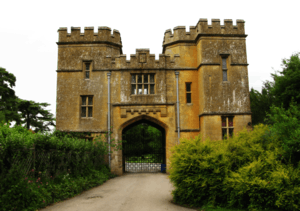
Sudeley Castle & Gardens is a castle located in the Cotswolds near Winchcombe, Gloucestershire, England. The present structure was built in the 15th century and may have been on the site of a 12th-century castle. The castle has a notable garden, which is designed and maintained to a very high standard. The chapel, St. Mary's Sudeley, is the burial place of Queen Catherine Parr (1512–1548), the sixth wife of King Henry VIII, and contains her marble tomb. Unusually for a castle chapel, St Mary's of Sudeley is part of the local parish of the Church of England. Sudeley is also one of the few castles left in England that is still a residence. Because of this, the castle is only open to visitors on specific dates and private family quarters are closed to the public. It is a Grade I listed building (first listed in 1960),[1] and recognised as an internationally important structure.[2] In March 2014 the castle opened up more private rooms including rooms which have never been open to the public before, and devised a new route through the castle and gardens.[3]
History
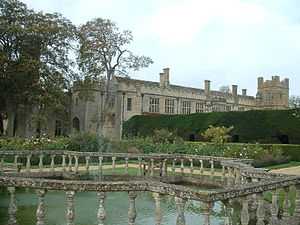
A castle may have been built on the site during the reign of King Stephen (1135–1154).[4] In 1442, Ralph Boteler who was created Baron Sudeley by Henry VI of England, built the actual castle on its present site using what he had earned fighting in the Hundred Years' War. He built up quarters for servants and men at arms on the double courtyard that was surrounded by a moat. He also added state and family apartments on the second courtyard. The Chapel, which would become St. Mary's, and the Tithe Barn were also built under Boteler.
In 1469, Edward IV of England confiscated the castle from its owner, Ralph Boteler, 1st Baron Sudeley and gave it to his brother, the Duke of Gloucester, who later became Richard III of England. Richard would use the castle as a base for the Battle of Tewkesbury. The Duke would later exchange this property for Richmond Castle making Sudeley property of the crown. After Richard became king, he became owner of the castle for a second time. During his reign the Banqueting Hall with oriel windows and the adjoining State rooms, now in ruins, were built in place of the Eastern range of Boteler’s inner court as part of a Royal suite.
After Richard's death at the Battle of Bosworth, it passed to the new king, Henry VII, who then gave it to his uncle, Jasper Tudor, Duke of Bedford. By the time Henry VIII succeeded, the castle was the property of the Crown again.
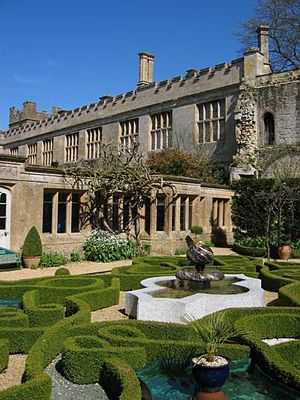
In 1535, Henry VIII and his second wife Anne Boleyn visited the castle, which had been empty and unattended for some time.
When King Henry died, the castle became the property of his son, Edward VI of England, who gave it to his uncle, Thomas Seymour who he made Baron of Sudeley. In early Spring 1547, Thomas married Edward's stepmother, the Dowager Queen Catherine Parr. At the announcement of her pregnancy in late 1547, Thomas began to renovate the castle for Catherine's use, but only one room that he built remains today. Lord Seymour and Queen Catherine decided that Catherine should move to Sudeley for the final months of her pregnancy. At about six months, Catherine was accompanied by Lady Jane Grey and a large retinue of ladies to attend on her, as well as over one hundred gentlemen of the household and Yeomen of the guard. Catherine's sister, Lady Pembroke, also came and attended upon her as her chief lady and groom of the stool. Catherine would give birth to her daughter, Lady Mary Seymour, on 30 August 1548 only to die on 5 September of that year. Catherine was buried in the Chapel. Her grave was discovered in 1728 after the castle and the chapel had been left in ruins by the English Civil War. She was later reinterred by the Rector of Sudeley in 1817 and an elaborate tomb was erected in her honor.
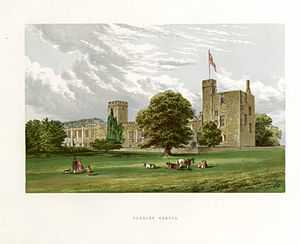
In 1549, Seymour's ambitions led him to being arrested and beheaded; after which, Sudeley Castle became the property of Catherine's brother, William Parr, Marquess of Northampton. After Parr's involvement with the plot to put Lady Jane Grey on the throne, he was stripped of his property and title by Queen Mary. Parr would regain his titles under Queen Elizabeth but the Castle remained property of John Brydges, 1st Baron Chandos.
In 1554, Queen Mary gave Sudeley Castle to John Brydges, 1st Baron Chandos, and it remained his property throughout the reign of Queen Elizabeth. It was at Sudeley that Queen Elizabeth was entertained three times and in 1592 a spectacular three-day feast to celebrate the anniversary of the defeat of the Spanish Armada was held.
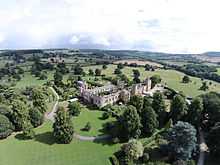
Current ownership
The current owners are Elizabeth, Lady Ashcombe, widow of Henry Cubitt, 4th Baron Ashcombe, and her two children — Henry (who married his wife Lili Maltese at the castle in 1998) and Mollie Dent-Brocklehurst. After the death of Lady Ashcombe's husband Mark Dent-Brocklehurst in 1972, she owns 50 percent of the equity, while her children each own 25 percent.
Mark inherited Sudeley in 1949 after the death of his father. His mother decided to stay at the castle though until 1969. It was at this time that Mark and his American born wife, Elizabeth decided to open up the castle to the public. [5] It took two years to convert the home into a tourist attraction only to see the death of Mark in 1972. With this event his wife and children were beset with massive debts and death duties. It was then that Lady Ashcombe decided to take on a 20th-century renaissance of the castle. After her marriage to Baron Ashcombe, the couple made major renovations to balance a visitor attraction with what is primarily a private residence.[6] Lady Ashcombe and her children have since taken over the management of the castle as a visitor attraction.[7]
The castle is sometimes used for high-profile events, such as the 2007 wedding of English actress Elizabeth Hurley to Indian textile heir Arun Nayar, which took place in the private chapel.
Hauntings
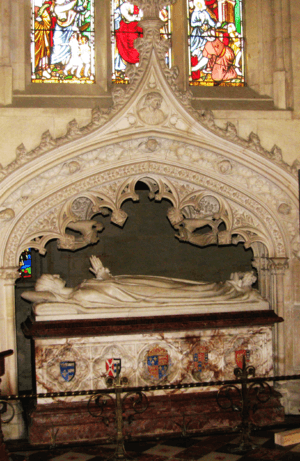
A few people have reported seeing a tall woman wearing a green Tudor styled dress, seen looking out of a window and walking through the Queen's garden; she is thought to be Catherine Parr, the sixth wife of Henry VIII. Many members of the household staff have reported seeing the Lady in Green. After Henry died in 1547, Catherine married Thomas Seymour, 1st Baron Seymour of Sudeley. Later that year, aged 35, Catherine gave birth to a daughter named Mary. A week later Catherine died of puerperal fever, and she was buried on the grounds of Sudeley in the Chapel of St. Mary. Her daughter, abandoned by her father, was taken in by Catherine's close friend Catherine Willoughby. There is no record of Mary Seymour after 1550.
A century later, during the civil war, the Chapel of St. Mary was ransacked and Catherine's casket disappeared. It was rediscovered in 1782 by a local farmer. He opened it up to find her well preserved body. After taking a few locks of hair he closed the casket and reburied it. In 1792 the casket was disturbed by two men who damaged it and buried it upside down. The casket was exhumed again in 1817 and Catherine's body moved to the tomb of Lord Chandos in St. Mary's Chapel.
Tourist Attractions
In March 2014 the castle opened up more private rooms including rooms which have never been open to the public before.
These rooms form part of an extended and revamped route around the castle, which includes the ‘20 Treasures of Sudeley’ – a collection of unique artefacts and works of art of great historical importance.
Katherine Parr Exhibition: Rare copies of original books written by Katherine Parr, the first queen to have her own work published, are displayed in an exhibition to celebrate this remarkable queen. The exhibition also features her love letters to Thomas Seymour and the eye-witness account of the discovery of her body at Sudeley in 1782. These, together with items taken from her tomb, help to illustrate Dr David Starkey’s film ‘The Life and Loves of Katherine Parr, Queen of England and Mistress of Sudeley’, which is shown alongside the exhibition. Guests can also visit Katherine Parr’s tomb in St Mary’s Church – Sudeley is notable for being the only private castle to have a queen buried in its grounds.Parr was the first woman and Queen to publish a book in English in England.
Richard III Exhibition: In April 2014 the castle was one of seven venues across the UK to host the official 3D facial reconstruction of Richard III, whose remains were found in a Leicester car park in February 2012. Sudeley Castle & Gardens was the last stop on the tour before the head returned to its final resting place in Leicester’s new King Richard III visitor centre, however a permanent Richard III exhibition remains at the castle.
Textiles Exhibition: The castle is notable for its textile collection, The Threads of Time exhibition. This features a collection of textile treasures from Sudeley’s history displaying textile techniques spanning over 400 years. This fine exhibition has been described as one of the best in the country and includes a 17th-century stumpwork casket, delicate lace and a Sheldon tapestry.
Seasonal Events: 2012 was the 500th anniversary of the birth of Queen Katherine Parr and a series of events took place at Sudeley Castle to commemorate its most remarkable former resident,[5] including an exhibition with a film introduced by David Starkey, talks by writers and historians and Tudor Fun Days.
The castle hosts regular events including talks from historians, children’s days, seasonal events, family fun days, jazz performances, picnics and book signings.
Cultural references
- BBC Four featured an investigation into the castle on 27 June 2007 titled Crisis At The Castle.[8] This detailed the turmoil associated with managing the castle within three sets of owners and their families.[9]
- Sudeley is regarded by many as the model for Blandings Castle in the novels by P. G. Wodehouse.[10] The adaptation for BBC television of Wodehouse's Heavy Weather (1995) was filmed there.
- Sudeley represented Matching Priory, home of Plantagenet Palliser and his wife Lady Glencora, in the 1974 BBC classic serial The Pallisers, based on six novels by Anthony Trollope.
- The BBC's investigation, Crisis at the Castle, highlighted the problems of running a family home as a visitor attraction. Closing the castle to the general public on some weekdays meant that visitors were disheartened when embarking on their day trips, and resulted in a dramatic fall in visitor numbers in the three years leading up to the creation of the program.
Gardens
Sudeley Castle’s nine individual gardens are world-renowned, providing variety and colour from spring through to autumn.
The centrepiece is the Queens Garden, so named because four of England’s queens – Anne Boleyn, Katherine Parr, Lady Jane Grey and Elizabeth I – once admired the hundreds of varieties of roses found in the garden.
St Mary’s Church, in which Katherine Parr is buried, is bordered by the White Garden, rich with peonies, clematis, roses and tulips, where Katherine and her companion, Lady Jane Grey would have entered the church for daily prayers.
The Knot Garden is based on a dress pattern worn by Elizabeth I in a portrait which hangs in the castle. Over 1,200 box hedges form its intricate geometric design, interspersed with coloured gravel and a Moorish mosaic fountain at the centre.
The ruins of the 15th Century Tithe Barn form the centre of a beautiful romantic garden, featuring a tranquil carp pond surrounded by wisteria, primroses, hollyhocks and cardoons.
Other gardens at Sudeley include the Secret Garden, the Mulberry Garden and the Herb Garden Walk. In the Mulberry Garden, country flowers and cool greenery surrounds the mulberry tree planted in 1865 by Emma Dent. The Herb Garden Walk takes visitors through a fine collection of plants which have been cultivated for their medical properties for thousands of years – even though many are poisonous.
Cottages
Sudeley Castle Country Cottages are located on the edge of the estate, midway between the castle and the historic town of Winchcombe. This small attractive complex of Cotswold stone cottages is set around a central courtyard with landscaped gardens and parking
The eleven cottages are all named for royal or significant people associated with the castle, and are available all year round.
See also
References
- ↑ Sudeley Castle, Heritage Gateway, retrieved 2011-12-30
- ↑ "Frequently asked questions", Images of England (English Heritage), retrieved 2011-12-30
- ↑ http://www.sudeleycastle.co.uk/news-views-lady-ashcombe/
- ↑ "Sudeley Castle", Pastscape (English Heritage), retrieved 2011-12-30
- ↑ 5.0 5.1 Emma Kennedy (June 1, 2012). "Emma's Eccentric Britain: afternoon tea with Lady Ashcombe". The Guardian.
- ↑ iccoventry.com: Lady Ashcombe
- ↑ Sudeley History Timeline
- ↑ BBC Four Documentaries: Crisis at the Castle
- ↑ The Guardian: Last night's TV: Crisis At the Castle
- ↑ N. T. P. Murphy (1981) In Search of Blandings